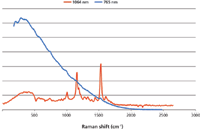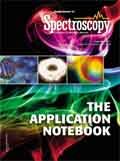Long-Wavelength Dispersive 1064 nm Raman: Improved Carbohydrate Measurements in Real Life Samples
Application Notebook
Overcoming fluorescence interference in a variety of samples is achieved by using dispersive 1064 nm Raman excitation instruments.
Overcoming fluorescence interference in a variety of samples is achieved by using dispersive 1064 nm Raman excitation instruments.
It has been documented that Raman spectroscopy is an effective technique for measuring glucose, fructose, and other carbohydrates. However, it is well-known that fluorescence found in many real life samples generates significant interference complicating Raman measurements (1).
Raman scattering is a spectroscopic technique capable of providing highly detailed chemical information about a variety of samples. However, a common problem with Raman spectroscopy has been interference from fluorescent molecules that are often present in the samples of interest. If present, fluorescence interference is typically orders of magnitude higher than the Raman signal. New long-wavelength 1064 nm Raman spectrometers are capable of overcoming this fluorescent background noise.

Figure 1: BaySpec's Xantus-1064 nm handheld raman spectrometer measuring sucrose in a corn stalk.
One nice example of the ability of these new long-wavelength Raman spectrometers to overcome fluorescence is shown with a live corn plant. Figure 1 shows a live corn stalk being measured in one of BaySpec's Xantus Raman spectrometers. The corn stalk was measured using both 785 nm laser excitation and 1064 nm laser excitation. The spectra collected with both of these excitation wavelengths are shown in Figure 2. With the 785 nm excitation a large fluorescence band is seen which obscures any Raman bands which may be present. However, when the 1064 nm excitation was used very clear Raman bands are seen and the band at 1159 cm-1 is consistent with sucrose being in the corn stalk (2).

Figure 2: Raman spectra of corn stalk measured with 785 nm excitation and 1064 nm excitation.
The new long-wavelength 1064 nm Raman spectrometers have been made possible because of the telecom boom and bust. This has created a Manhattan Project effect on the development of lasers and optical components. Ten years ago, optics, lasers, and detectors were limited to laboratories on bulky optical benches with sophisticated liquid nitrogen cooling and complicated alignment operations requiring a PhD to operate.
Today, without sacrificing performance in many cases, lasers are the size of your little finger; and detectors can be thermoelectrically cooled, doing away with liquid nitrogen. All these in addition to low-profile, surface-mount electronics enables spectrometers to be the size of your Blackberry or iPhone.
For the first time in analytical instrumentation history, a ruggedized dispersive long-wavelength 1064 nm Raman spectroscopic instrumentation is available for overcoming fluorescence issues seen at lower wavelengths.
This new instrumentation provides great potential for rapid on-line measurements of carbohydrates in real life samples.
Long-wavelength dispersive 1064 nm Raman spectrometers are now available from BaySpec. For more information on these and our complete line of spectroscopic instruments contact BaySpec.
References
(1) M. Mathlouthi and D.V. Luu, Carbohydrate Research 78, 225 (1980).
(2) W. Szarek, S. Korppi-Tommola, H. Shurvell, V. Smith, and O. Martin Canadian Journal of Chemistry 62, 1612 (1984).
BaySpec, Inc.
1101 McKay Drive, San Jose, CA 95131
tel. (408) 512-5928; Email: info@bayspec.com
Website: www.bayspec.com

Thermo Fisher Scientists Highlight the Latest Advances in Process Monitoring with Raman Spectroscopy
April 1st 2025In this exclusive Spectroscopy interview, John Richmond and Tom Dearing of Thermo Fisher Scientific discuss the company’s Raman technology and the latest trends for process monitoring across various applications.
A Seamless Trace Elemental Analysis Prescription for Quality Pharmaceuticals
March 31st 2025Quality assurance and quality control (QA/QC) are essential in pharmaceutical manufacturing to ensure compliance with standards like United States Pharmacopoeia <232> and ICH Q3D, as well as FDA regulations. Reliable and user-friendly testing solutions help QA/QC labs deliver precise trace elemental analyses while meeting throughput demands and data security requirements.